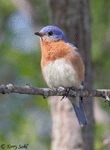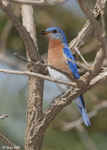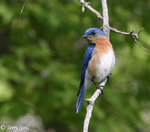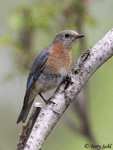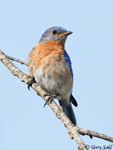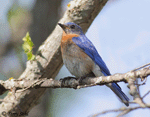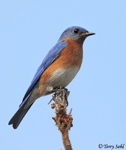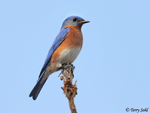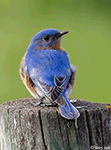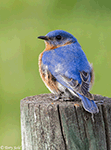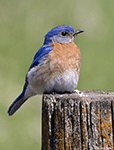Eastern Bluebird
Sialia sialis
| Length: 7 - 8 inches | Wingspan: 11.5 - 13 inches | Seasonality: Summer |
| ID Keys: Bright blue upperparts, rusty brown chinstrap, throat, and breast, white belly | ||
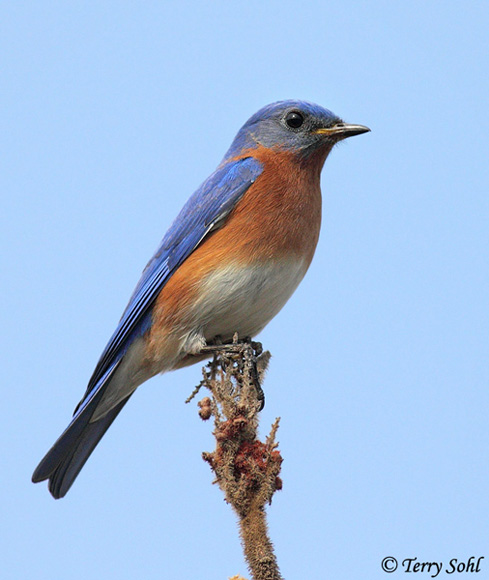 A
favorite summer visitor for many, the Eastern Bluebird is more common in the
eastern part of the state. They historically have used old woodpecker
holes and other cavities in trees for nesting. However, they will readily
nest in man-made bluebird boxes, and have greatly benefited from the increased
placement of these boxes, especially as
European Starlings have become aggressive competitors for natural tree
cavities for nesting.
A
favorite summer visitor for many, the Eastern Bluebird is more common in the
eastern part of the state. They historically have used old woodpecker
holes and other cavities in trees for nesting. However, they will readily
nest in man-made bluebird boxes, and have greatly benefited from the increased
placement of these boxes, especially as
European Starlings have become aggressive competitors for natural tree
cavities for nesting.
Habitat:
Eastern Bluebirds can be found in a variety of open and semi-open habitats. They prefer open country interspersed with trees for nesting.
Diet:
Mostly insects during the summer months, as well as other small invertebrates such as worms, snails, and spiders. They also eat many berries, particularly during the winter months where berries may be the primary food source. More rarely they will eat small vertebrates such as small frogs, snakes, lizards, or small rodents.
Behavior:
Often feeds by observing from a relatively low perch and flying down to pluck insects from the ground or foliage, often hovering instead of landing while taking the food item. They will also sometimes fly out and catch insects in mid-air. Breeding pairs may perch next to and preen each other.
Nesting:
Late April through July. Eastern Bluebirds are cavity nesters, traditionally using natural cavities (particularly old woodpecker nesting sites), but also now accepting nest boxes specifically built for the species. Male Bluebirds entice the female by selecting a nesting site and moving in and out of the cavity, carrying nesting material and calling to the female. The female herself builds the nest, lining the cavity with grasses and sometimes other vegetative material. The female lays between 3 and 7 eggs, and she alone incubates them. The young hatch after about 14 days, and fledge from the nest about 2 to 3 weeks after hatching.
Song:
The song of an Eastern Bluebird is a series of warbled phrases. The call is a tur-a-lee. They also have various harsher calls and short chip notes.
- Click here to hear the song of an Eastern Bluebird1
- Click here to hear the call of an Eastern Bluebird2
- Click here to hear the chattering alarm call of an Eastern Bluebird3
Migration:
Winters in the southeastern United States and Mexico, although small numbers may winter in the state in selected spots. Summers throughout most of the eastern half of the United States and southeastern Canada. Many populations in the southeastern quarter of the United States are permanent residents, as are birds in Mexico and Central America.
Interactive eBird Map:
Click here to access an interactive map of Eastern Bluebird sightings
Similar Species:
Similar to other Bluebird species
- Western Bluebird - There's no real range overlap between Western Bluebirds and Eastern Bluebirds (Western Bluebirds are but extremely rare visitors to South Dakota), but occasionally stray birds may cause some confusion. Western Bluebird males have a completely blue head and throat, while Eastern Bluebird males have chestnut-colored throats. Western Bluebirds have bluish bellies, while Eastern Bluebirds have a white belly. Females are perhaps more difficult to distinguish, but Western Bluebird females have grayish underparts and a grayish throat, while those same features are white on a female Eastern Bluebird.
- Mountain Bluebird - Mountain Bluebirds and Eastern Bluebirds may occasionally be found together in South Dakota. Mountain Bluebirds males are more completely blue, with lighter blue below and a sky blue on their breast and flanks, while an Eastern Bluebird has an orangish breast. Female Mountain Bluebirds have a lighty buffy color on the belly and throat, while those features are white on an Eastern Bluebird.
 |
 |
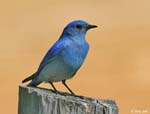 |
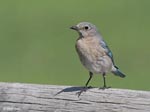 |
| Western Bluebird | Western Bluebird | Mountain Bluebird | Mountain Bluebird |
Bird Feeders:
Will sometimes attend feeders for mealworms (yes, you can buy mealworms to feed to bluebirds!)
Conservation Status:
Eastern Bluebirds experienced sharp declines in the first half of the 20th century due to competition for nesting sites with non-native species (European Starling, House Sparrow). Eastern Bluebirds have been recovering in recent decades, thanks in large part to the large numbers of nest boxes erected for their benefit. The IUCN currently lists Eastern Bluebirds as a species of "Least Concern".
Further Information:
Photo Information:
March 30th, 2012 - Beaver Creek Nature Area near Brandon, South Dakota - Terry Sohl
Additional Photos:
Click on the image chips or text links below for additional, higher-resolution Eastern Bluebird photos.
Audio File Credits:
- 1Jacob Saucier. Recorded in Avoyelles Parish, Louisiana on December 21st, 2017. Original recording and information from xeno-canto.
- 2Richard E. Webster. Recorded in Sonora, Mexico on July 29th, 2019. Original recording and information from xeno-canto.
- 3Richard E. Webster. Recorded in Sonora, Mexico on August 16th, 2013. Original recording and information from xeno-canto.
| Click on the map below for a higher-resolution view |
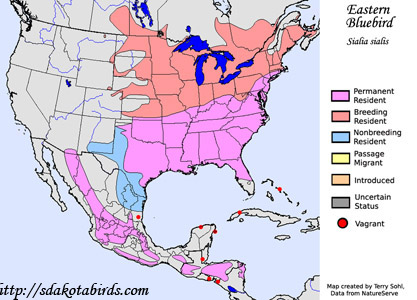 |
| South Dakota Status: Uncommon migrant and summer resident throughout the state. Very rare winter visitor, primarily in the extreme southeastern corner of the state. |
Additional Eastern Bluebird Photos
Click for a higher-resolution version of these photos
